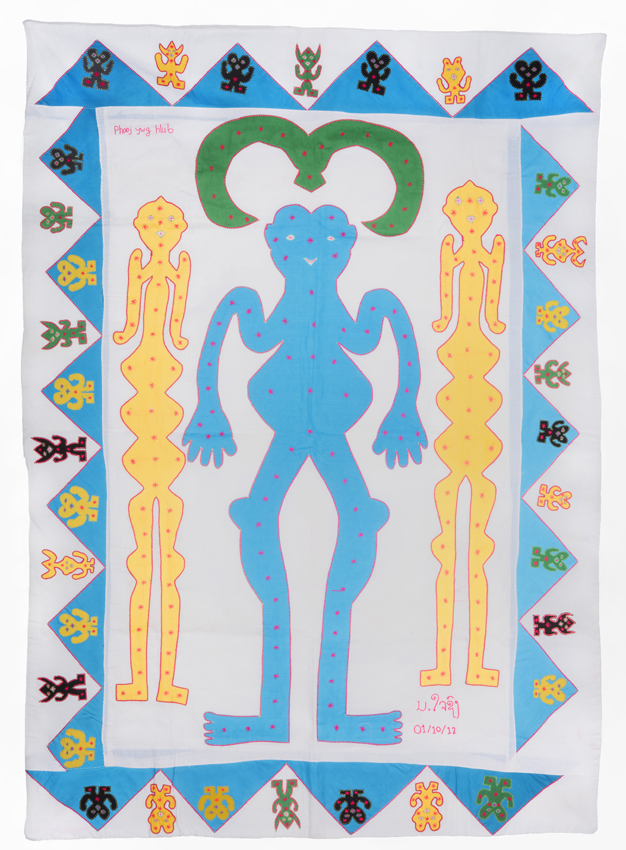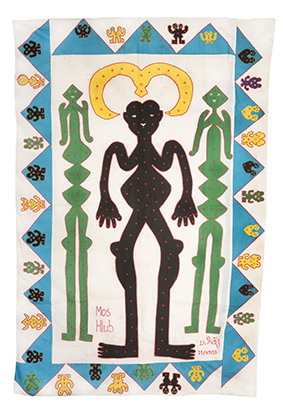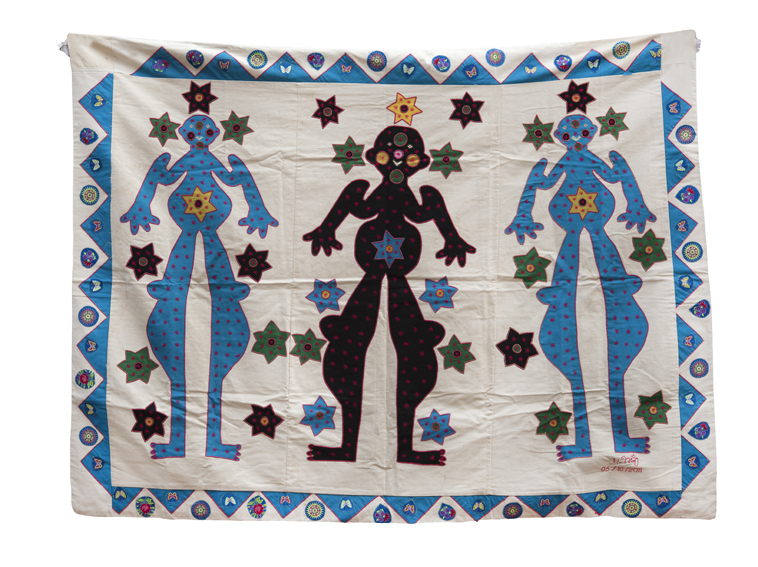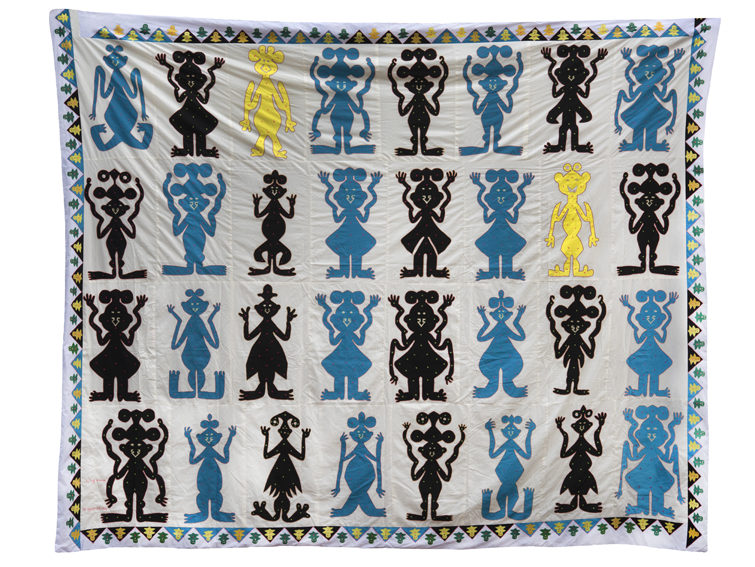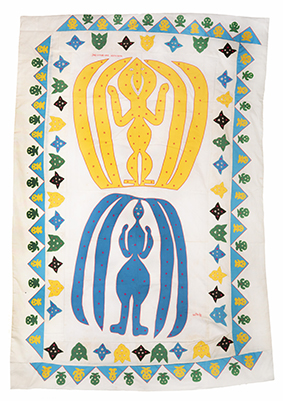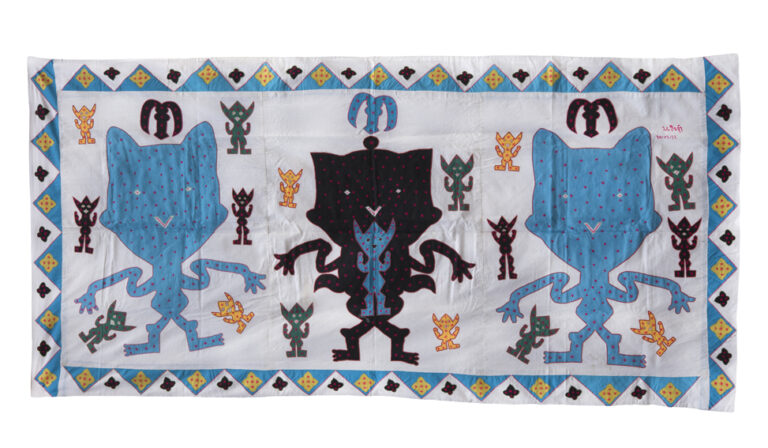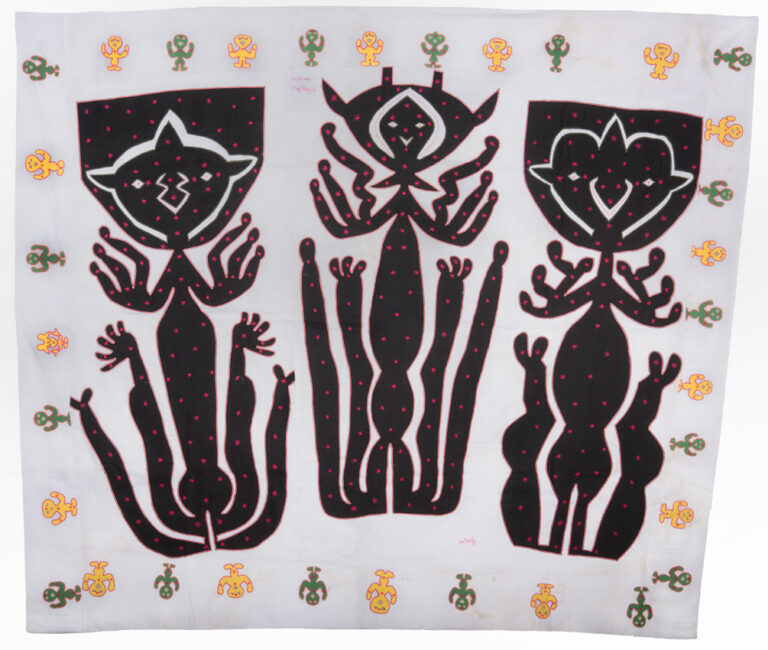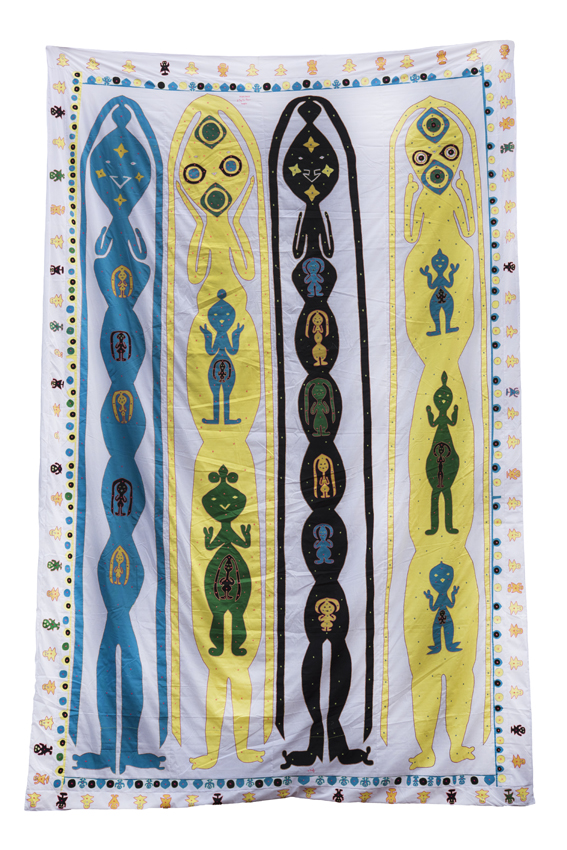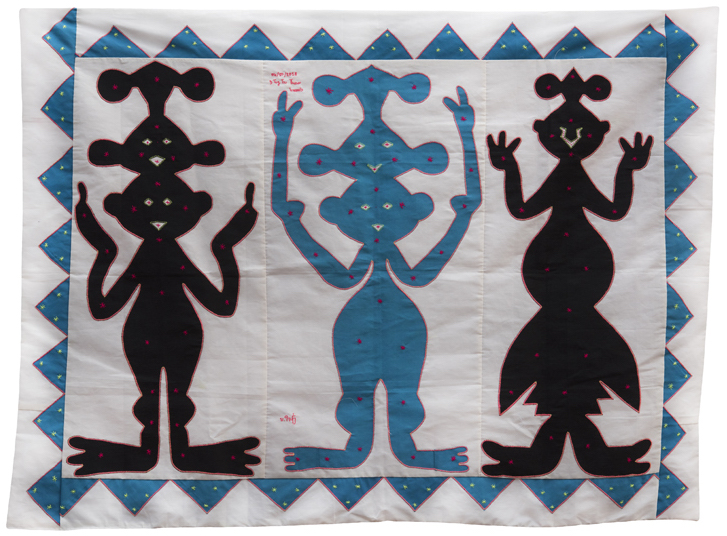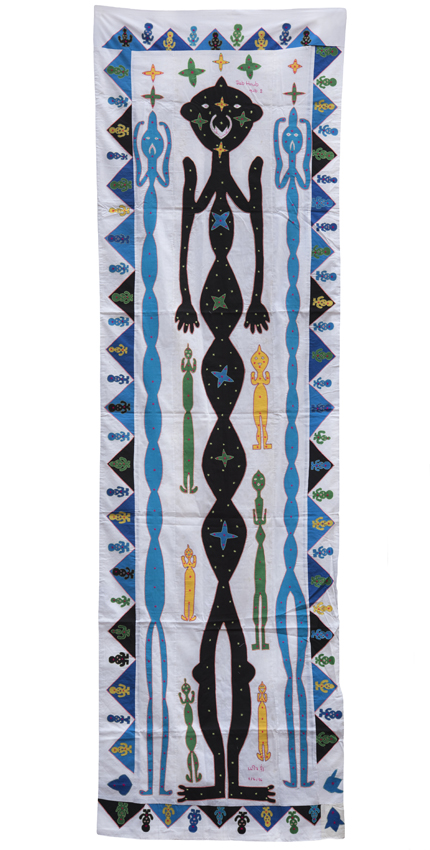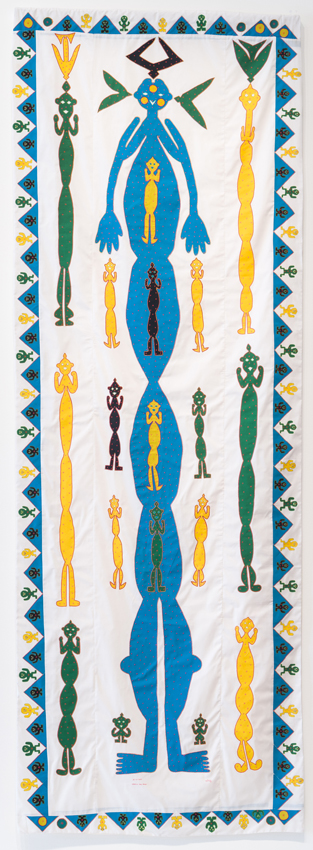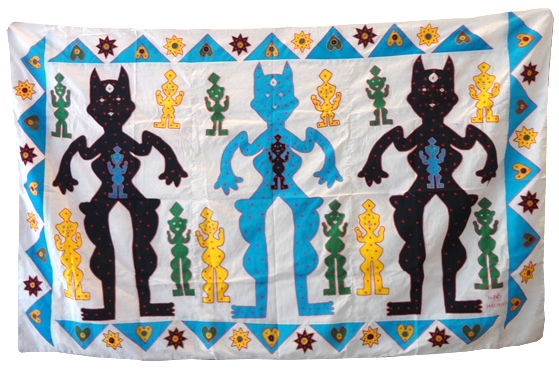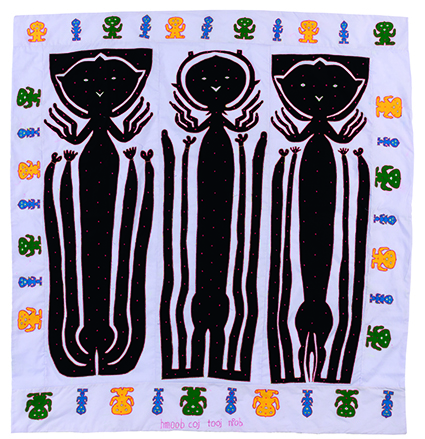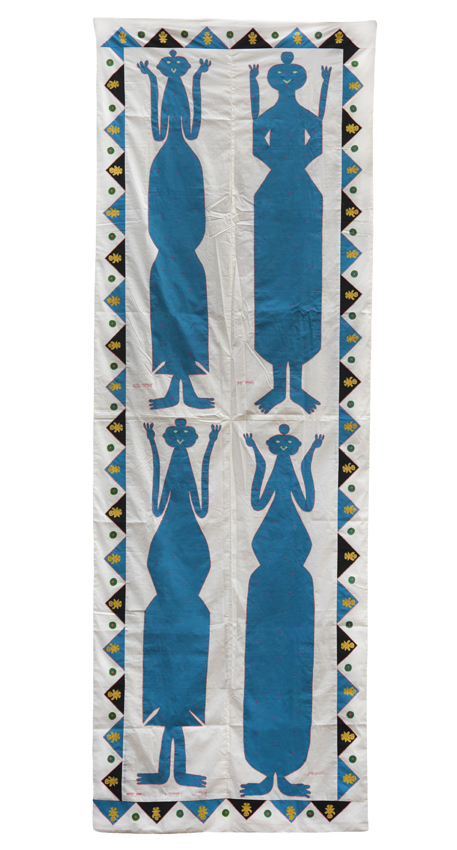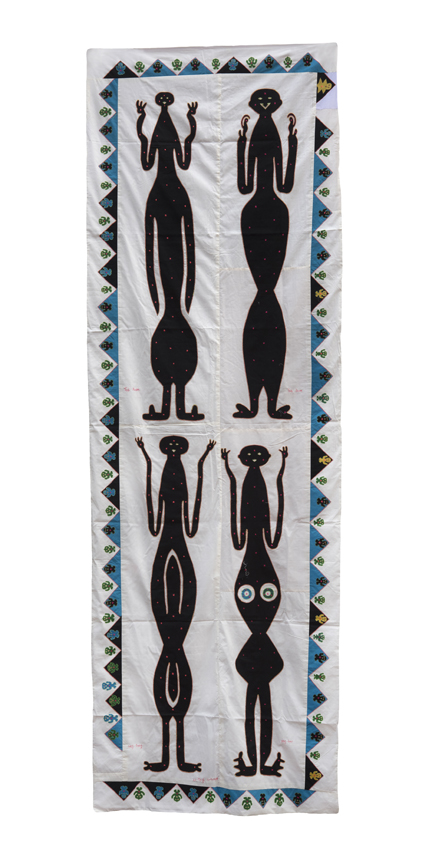ຈື່ ຊົ່ງ ເປັນນັກສິລະປິນທີ່ຮຽນຮູ້ສິລະປະດ້ວຍໂຕເອງ ເຊິ່ງມີປະສົບການຫຼາກຫຼາຍດ້ານການແສ່ວຜ້າ ດ້ວຍການນຳໃຊ້ເຕັກນິກການແສ່ວຜ້າຂອງຊົນເຜົ່າມົ້ງດັ້ງເດີມ ມາປະສົມປະສານກັບເລື່ອງລາວ ເພື່ອສ້າງສັນຮູບຮ່າງທີ່ໂດດເດັ່ນເທິງຜືນຜ້າ, ເຖິງແມ່ນເຕັກນິກດັ່ງກ່າວຈະເປັນສ່ວນສໍາຄັນທາງວັດທະນະທໍາຊາວເຜົ່າມົ້ງມາແຕ່ດົນນານຜ່ານຫຼາຍສະຕະວັດ, ແຕ່ອົງປະກອບ ແລະ ການຢຶດຖືຂອງ ຈື່ ຊົ່ງນັ້ນແຕກຕ່າງຈາກປະເພນີມົ້ງ ທີ່ເນັ້ນໂຄງສ້າງໃນລັກສະນະທີ່ເປັນນາມມະທໍາແບບເລຂາຄະນິດ ໂດຍນິຍົມໃຊ້ລວດລາຍທີ່ເປັນທໍາມະຊາດ ພ້ອມສ້າງສັນຮູບຮ່າງທີ່ຊັດເຈນ. ເຖິງແມ່ນຜົນງານຂອງລາວຈະມີຄວາມແຕກຕ່າງ, ແຕ່ຜົນງານດັ່ງກ່າວກໍຍັງເປັນຟັງຊັ່ນເຊີງສັນຍະລັກຂອງການອອກແບບມົ້ງ ໃນການສະແດງເອກະລັກ ແລະ ວັດທະນະທໍາ ຜ່ານພາສາຮູບພາບໃນວັດທະນະທໍາບອກເລົ່າ. ຂະບວນການຂອງ ຈື່ ຊົ່ງ ມີຄວາມກ່ຽວຂ້ອງກັບການໄດ້ຮັບພາບໃນຄວາມຝັນຂອງລາວ ຕະຫຼອດເຖິງການອອກແບບດ້ວຍຕົນເອງ ເພື່ອອອກແບບ ແລະ ວາງແຜນຕົວລະຄອນທີ່ບໍ່ມີຈຸດສິ້ນສຸດໃນໂລກແຫ່ງວິນຍານຂອງຊາວເຜົ່າມົ້ງ.
Tcheu Siong – “The Spirits Guide the Scissors”
Tcheu Siong (1968) widowed in 2022, was married to a shaman, Phasao Lao, and they have had ten children, of whom five still living. Among themselves, they always speak Hmong, around her area, everyone is White Hmong (Hmoob dawb). All her family came from a village, about two hours by bus north from Luang Prabang, but in 1996 they had to leave the mountains and come to live in town.
Tcheu is a self-taught artist with a prolific textile practice in hand stitched embroidery and reverse appliqué. While such techniques have been integral to Hmong culture for centuries, Tcheu’s compositions and iconography depart from Hmong traditions of geometric abstraction, favouring organic and bold figurative motifs. While differentiated, her works retain Hmong designs’ symbolic function to express identity and culture through a visual language within an oral culture. Tcheu’s process involves both receiving images in her dreams as well as creating her own designs in order to design and plot the infinite characters populating the Hmong spirit world. While at times her compositions narrate specific oral histories, at other times Tcheu welcomes multiple readings of her work. In the artist giving presence to the unseen, she in turn gives agency to the active and complex role of spirits in everyday life, such as those for fertility or good health, to those who invoke punishment for harming the land, to elder spirits who train adolescent ones how to govern fairly.
Favouring large scales works up to four by five meters Tcheu Siong says that the characters in her works come from dreams and visions, and it is these zones between consciousness and dreaming that these cut-out figures develop. Dreams are the path to this other world, a world which one obeys because it elucidates. What sort of metamorphosis occurs thus from the connections between a woman, her imagination, her world, her childhood, her demons and her aspirations. Isn’t it the purpose of artistic creation to weave these connections ? One sees a constant back and forth between dreams, myths, and images. Among these three things operate constant exchange and creative association. The art of Tcheu Siong, steeped in these close relationships, which are also expressed in other ways, like Siong’s, stories, mourning chants, sends one back to a world where the lines blur between the living and the spirits, and make an echo.
Is it possible that dream-stories, fragments of myth and Siong’s can fuel the transformation of physical elements, the figures, the cut-out shapes, that are appliquéd onto the fabric? What sort of metamorphosis occurs thus from the connections between a woman, her imagination, her world, her childhood, her demons and her aspirations.
She says: “Now my husband has died I feel alone and would like to fly to another country to visit and discover more of the world”.
In 2010 she had her first exhibition at Project Space Gallery in Luang Prabang and afterwards has been invited to important exhibitions such as amongst others: the Singapore Biennial (2016); APT9 at the Queensland Art Gallery (2018); “Elevations Laos”, I:Cat Gallery, Vientiane (2018); the Asian Art Biennial, Taipei (2019); the 13th Gwangju Biennal South Korea (2021); and is currently part of a group show at the Dowse Art Museum in New Zealand: “Whetūrangitia / Made As Stars”. In December 2023 she exhibits in Chiang Rai at the Thailand Biennial as the only Laos artist.


